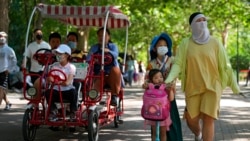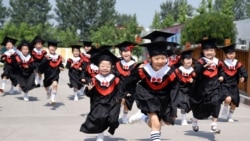After three decades of abortions during the one-child era, the procedure advertised in China as “safe, quick and painless” at bus stops, in magazines and on flyers is now facing restrictions.
In the newly issued Guidance on Women’s Development 2021-2030 by China’s State Council, the phrase calling for “reducing non-medically necessary abortions” caught the public’s attention.
The notice, released September 27 with no specific details on enforcement, sparked discussion among netizens.
VOA Mandarin found 40,000 comments under an article on the directive published on China’s 163.com.
“I guess we have to draw lots to buy condoms in the future,” said one, referring to the government's efforts that began earlier this year to encourage people to have three babies after the one-child policy strained a rapidly aging society.
Another read, “From forced abortion to forced childbirth, the government is using all tools to achieve its goal.”
“Don’t worry about abortion,” said a third. “I won’t have babies if you kneel down and beg me!”
Activists criticized the government’s interference with women’s reproductive rights.
Zhang Jing, the founder of Women’s Rights in China, a New York-based NGO, told VOA Mandarin that the reduction of non-medically necessary abortions is another example of how Beijing authorities interfere with women’s reproductive rights.
“Now that the Chinese government has noticed there’s a population shortage, they are reversing the policies to encourage people to have babies. I do believe this is going to be mandatory,” she told VOA Mandarin in a phone interview last week.
“From forced abortions in the one-child policy era, to forced childbirth in the three-child policy era, human rights, as well as women’s rights, were not taken into consideration in the formation of these population policies,” she added.
Chen Guangcheng, a Chinese civil rights activist and the author of The Barefoot Lawyer: A Blind Man’s Fight for Justice and Freedom in China, worried about whether the new policy meant China would soon ban all forms of abortion.
“The Chinese Communist Party changes its policies based on its own needs,” Chen, who fled China in 2012, told VOA Mandarin via phone. “I don’t think there’s any long-term consideration. … I think, essentially, this violates women’s reproductive rights.” Chen, a women’s rights advocate, spoke against forced abortions during the one-child era, which ended in 2016.
Yi Fuxian, a senior scientist at the University of Wisconsin-Madison and author of Big Country With an Empty Nest, argued that the new guideline was a step in the right direction.
“Although China will regulate abortion, I don’t think the policy will be as strict as the ones in the U.S. or Australia,” he said in a phone interview. “Individuals will still have a lot of freedom to make decisions. I don’t think we should overinterpret this one-liner in the guidelines. The decline in fertility rate is a global trend. I think it’s necessary to explore ways to increase fertility rate.”
Struggling with an aging population and declining birth rates, the Beijing authority is trying to shift its population policies to avert a demographic crisis.
Census figures published in May by China's National Bureau of Statistics showed that China’s population growth from 2011 to 2020 was the slowest since the 1950s. The birth rate fell for four consecutive years after Beijing abandoned the one-child policy in early 2016. And in 2020, only 12 million babies were born, the lowest number since 1961.
In a major policy shift this May, China announced that married couples may have up to three children in order to boost the country’s birth rate.
Meanwhile, the census showed in 2020 that 264 million people were age 60 or older and that 191 million were age 65 or older, constituting 18.7% and 13.5% of the total population, respectively. In about 25 years, one-third of China’s population will be retirees, and their living and health care expenses will eat up a quarter of Beijing’s GDP.
While the country is facing a shrinking labor force, China’s abortion rates remain high, following a pattern established during the 30-plus years of one-child policy when forced abortions and sterilization were widespread.
According to an article published by the government’s China Population and Development Research Center, part of the National Health Commission of China, Chinese public hospitals performed an average of 9 million abortions annually from 2005 to 2017. The article pointed out the real number was closer to 13 million annually because the previous number didn’t include statistics from private hospitals and clinics.
In 2017, China performed 9.6 million abortions, accounting for over 17% of the total abortions performed worldwide, according to the article. Among those who had abortions, 55.9% of the women had more than two abortions, according to the article.
Yi from the University of Wisconsin-Madison said it’s time for China to regulate abortions.
“When China implemented the one-child policy, abortions were literally everywhere. I think that’s a disrespect of women’s reproductive rights,” he said. “Now as the population policy changes, I’m seeing a change of attitude from ‘too many lives is a burden’ to ‘respect lives,’ and this change will lead to more regulation in terms of abortion procedures.”
Yi continued, “I think this is a change that should be respected and welcomed by the international community, rather than being criticized.”
Lin Yang contributed to this report.










